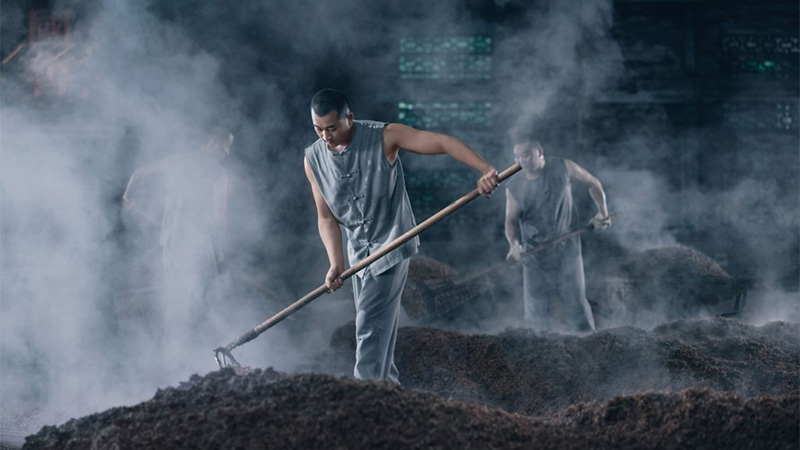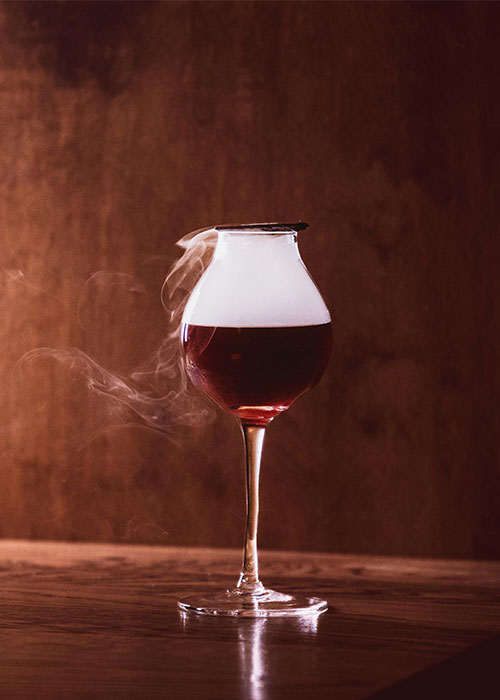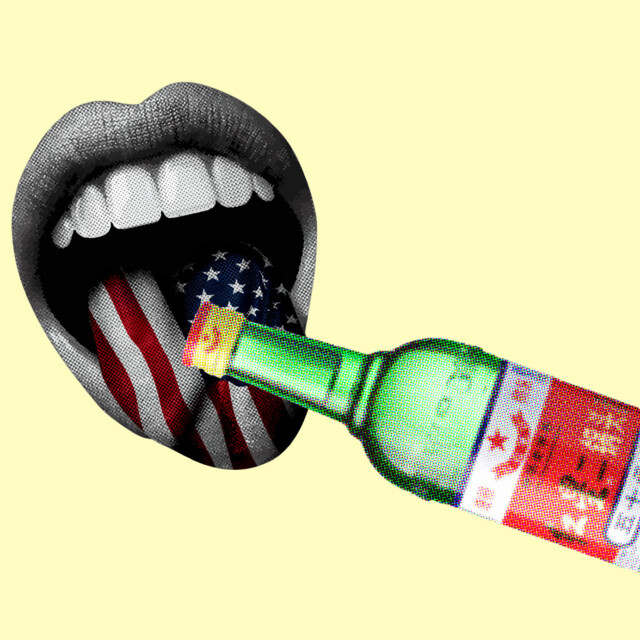When asked to think about the world’s most popular spirit, American minds will likely drift to liquors like vodka or whiskey, maybe even rum if they’re being ambitious. So most would likely be shocked to learn that the spirit claiming the No. 1 spot is baijiu, a sorghum-based Chinese spirit dating all the way back to the Yuan Dynasty that lives in relative obscurity outside the country’s borders.
But change may be on the horizon. In recent years, a slew of Asian-owned restaurants and cocktail bars have opened in New York City, the Bay Area, and beyond, and have rapidly cemented themselves as must-visit establishments. These bars and restaurants are pushing the boundaries of what it means to create a great cocktail, whether through food-inspired drinks like those served at NYC’s Double Chicken Please, or incorporating techniques native to the region, as is the case with the izakaya food and drink dished out at the newly opened Sip & Guzzle.
Beyond creating world-class cocktails with inventive approaches and techniques, these beverage programs are introducing American palates to ingredients and spirits native to Asian countries. One of those spirits: baijiu. The only problem? Baijiu’s profile.
Most often associated with bold and complex umami flavors that can border on rubbery, baijiu is definitely an acquired taste — especially considering the spirit’s traditionally high ABV. But if Americans can learn to love spirits like mezcal, which has a similarly challenging profile that worked its way into cocktail bars in the early aughts, perhaps the door is finally open for baijiu’s Western success.
Can Americans Get With the Funk?
When mezcal first landed in the United States, it had a similar reputation to the baijiu that’s been slowly trickling into beverage programs stateside. And it was not good.
“There was a huge learning curve with mezcal, especially the stuff that was coming out in the early 2000s,” says Joaquín Simó, a spirits professional and drinks consultant credited with the creation of the Naked and Famous. “I mean, there were products like Los Amantes and Del Maguey, but there weren’t many and, for the most part, you had garbage, sticky, trash mezcal that was really challenging.”
But that all changed with a bit of education, recontextualization, and thoughtful cocktail creation. Simó himself recalls his mind being blown the first time he tried the Oaxaca Old Fashioned, a mezcal cocktail created by his then-colleague Phil Ward at Death & Co. in 2007. “I had no idea it could be like that,” he says.
Much of mezcal’s altered perception stateside was due to the efforts of Del Maguey founder Ron Cooper, who not only traversed Mexico to find the best mezcal to bring into the U.S., but also brought journalists, bartenders, and spirits professionals along with him. As drinks like the Naked and Famous and the Oaxaca Old Fashioned later emerged from a beloved NYC cocktail institution, other bars caught on, and mezcal developed a stronghold in cocktail programs. Mezcal producers responded to the uptick in interest.
And despite the relatively challenging flavor of the Mexican agave spirit, Americans seem to love the stuff. In 2010, mezcal exports as a whole were estimated to be around 67,800 cases. In 2023, Impact Databank estimates that mezcal exports to the U.S. exceeded 803,000 cases, an roughly 1,000 percent increase in just 13 years. Looking ahead, the spirit is predicted to grow 10.79 percent year-over-year until 2032.
“The journey of mezcal from a niche offering to a more mainstream spirit highlights the potential for unique and culturally significant products to find wider acceptance.”
Baijiu appears to be currently overcoming the same obstacle mezcal hurdled over in the late 2000s.
“When I think about the baijiu served eight, 10 years ago during a tasting at Tales of the Cocktail, it was not good. It was real bad. It kind of tasted like baby vomit,” Simó says. “But we’ve hit a tipping point where they’re actually exporting good sh*t and you’re starting to see real quality come from the greater category as a whole.”
Strong Flavors vs. Strong Flavors
While mezcal and baijiu each present a challenge on the palate, baijiu’s cultural associations — and the way the spirit is consumed in its home country — may present more difficulties when it comes to American acceptance.
Ray Zhou, who trained at Double Chicken Please and recently opened Chinato, a Chinese cocktail bar on NYC’s Lower East Side, argues that baijiu and mezcal likely won’t follow the exact same trajectory, but the former can definitely achieve the same modest success. “The journey of mezcal from a niche offering to a more mainstream spirit highlights the potential for unique and culturally significant products to find wider acceptance,” he says.
Similarly to mezcal, baijiu is traditionally consumed neat. However, while mezcal is typically sipped slowly from dried gourd jícaras, baijiu could not be more different, traditionally consumed as an accompaniment to culinary creations — spicy ones at that.
“Baijiu’s strong and unique flavors pair best with bold and intense flavors — think sour, numbing, spicy, and even bitter dishes,” Zhou explains. “But this presents a challenge in Western contexts, where drinking habits and culinary preferences differ.”
In regions like Sichuan, dishes are chock full of peppers, chilies, garlic, and ginger. But the intensity of the flavors makes for baijiu’s perfect foil, with a slightly numb palate more readily accepting of the spirit’s intense proof and pungent bite. Plus, the subtleties of baijiu, like its fruity funk, work to coat the mouth, making extremely spicy dishes taste less intense while simultaneously revealing more delicate flavors in the spirit. It’s no coincidence that over half of all baijiu produced originates in Sichuan province.
“Baijiu needs to be discussed in the context of strong flavors in relation to other strong flavors.”
When Derek Sandhaus moved to Chengdu, Sichuan’s capital city, in 2011, he fell in love with the spirit, and the raucous culture surrounding its consumption. In 2014, he published his first book, “Baijiu: The Essential Guide to Chinese Spirits,” and later met Bill Isler and Matthias Heger while delivering a talk on the work. In 2018, the three expatriates, along with Simon Dang, launched Ming River, a Sichuan-style baijiu produced at Luzhou Laojiao, the longest continuously operating distillery in China.
When it came to convincing non-Chinese drinkers to hop on the baijiu train, Sandhaus explains that all it took was the proper contextualization: food. “We found that a lot of the negative stigma surrounding baijiu, particularly among expats living in China, was removed rather easily if you just put people in a setting where they can sit down and take a few sips of different styles with the cuisine.”
As for baiju’s positioning in the United States, Simó argues that the spirit, with its umami-rich palate, must be contextualized the same way, similarly to how sherry established a niche stateside.

“With sherry, people generally understand that it is either being consumed on its own with a specific kind of food, or mixed into drinks that are designed to pair with that food,” he says. “In that sense, baijiu feels more aligned with sherry than mezcal in my mind, especially in terms of how it’s going to achieve market penetration.”
However, if baijiu requires spicy food as a foil, and Americans aren’t yet comfortable shooting the stuff straight, can the cocktail prove to be the perfect middle ground? Sandhaus says yes.
The funky spirit works extremely well with the intense, tropical flavors in tiki-style cocktails and also makes for a great accompaniment to other strong beverages like amaro, Chartreuse, Aperol, and even mezcal.
“Baijiu needs to be discussed in the context of strong flavors in relation to other strong flavors,” he says. “Philosophically, of course this works in cocktails because it was all intended to be paired with other flavors. It’s just about discovering what those flavors are in a liquid context.”
Baijiu’s American Liquid Context
At Chinato, baijiu is used in multiple of applications, the most popular being the bar’s namesake drink, the Chinato. The cocktail combines Ming River baijiu and Cocchi Barolo Chinato — both of which feature a bitter bayberry and goji berry infusion — with bourbon, lychee black tea, and a bayberry chocolate garnish. It’s a complex drinking experience, one that truly takes the palate on a journey. The spirit was also the star on the bar’s Baijiu and Brews menu, which ran for a limited time to celebrate the Lunar New Year. The three cocktails featured baijiu stirred up with a variety of beers and ingredients like Chinola Passion Fruit liqueur, parsnip, yuzu, and jujube.
“Chinato remains the undisputed top seller in our bar and notably, has played a pivotal role in changing many people’s perceptions of baijiu,” Zhou says. “And as for Baijiu and Brews, the three drinks have been exceptionally well-received by our customers, and due to popular demand, we’ve been asked to consider adding some of these to our menu permanently.”

The LES bar isn’t the only one in Manhattan changing perceptions with baijiu cocktails. Down in the Financial District, Manhatta serves the Berry Me in NYC, a refreshing cocktail combining baijiu with Shiraz, Pimms, cucumber, ginger, and soda. Meanwhile, over in San Francisco, the newly opened Polkcha is receiving acclaim for its unique baijiu and vodka lychee sour. Across the bay, Oakland’s vibrant and eclectic Viridian offers a unique twist on the Negroni with baijiu starring alongside gin, sweet vermouth, a house aperitivo, and xtabentún, a Mexican anise liqueur.
However, while baijiu has won over drinkers in bars and restaurants through well-balanced, flavor-forward cocktails, there’s a new set of challenges presented when it comes to the liquor’s place in retail stores. Where mezcal has the popularity of tequila — and its “smoky tequila” reputation — to fall back on, no similar point of reference exists for baijiu. And to make matters worse, there’s hardly enough baijiu in the United States to even create that point of reference.
“If we wanted to go into a liquor store and ask the owner to carry our baijiu, the first question that comes out of their mouths is ‘Well, where do I put it on my shelf? There’s no baijiu section,’” Sandhaus explains. “Should they put it next to the rum? The sake? The weird chocolate liquor hanging out in the corner? So that’s tricky because even if you get really into baijiu, you just can’t find a lot.”
Can Now Be the Time?
When Sandhaus and co. launched Ming River stateside in 2018, one could likely count the number of bars and restaurants carrying baijiu on both hands, he says. That year, the brand was only available in two countries and two U.S. states. Now, you can find it in 15 countries and 30 states.
“We’ve reached the point where it’s not just us pushing our product, there’s actually people reaching out to us,” he says. “We get emails every week from restaurants and bars in places like Richmond, Memphis, and Charleston asking how they can get our product and how we can work together.”
In the context of the larger drinks industry, there’s never been a better opportunity for baijiu to succeed in the U.S. American palates have acclimated to mezcal, bitter amaros have cemented their place on cocktail menus — with the popularity of the Negroni to prove it — and people can’t stop drinking Dirty Martinis. The door certainly seems open for baijiu’s western success, so long as bartenders and beverage directors remain thoughtful in their application of the spirit — and patient when it comes to educating others on its complexities.
“I think it’s hard to say that a culture that is slinging back Dirty Martinis like they’re dying of thirst can’t get down with an umami-forward, savory beverage,” Simó concludes. “We just have to have a different vocabulary when it comes to describing baijiu, and that’s what you have to get people to understand.”
This story is a part of VP Pro, our free platform and newsletter for drinks industry professionals, covering wine, beer, liquor, and beyond. Sign up for VP Pro now!
